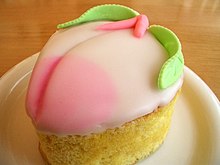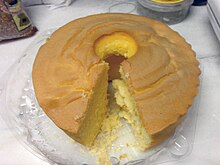| Revision as of 21:20, 17 November 2020 edit72.224.13.12 (talk) Restored to version by Drmies, basically re-added content that were removed for being not properly sourcedTags: Manual revert Reverted references removed← Previous edit | Revision as of 21:54, 17 November 2020 edit undoHorse Eye's Back (talk | contribs)Autopatrolled, Extended confirmed users51,745 edits Undid revision 989241475 by 72.224.13.12 (talk) cleanup on aisle 11!Tags: Undo RevertedNext edit → | ||
| Line 42: | Line 42: | ||
| Castella were first introduced to Taiwan during the age of ]. In 1968, Ye Yongqing, the owner of a Japanese bakery in Taipei named ''Nanbanto'', partnered with the Japanese company ''Nagasaki Honpu'' to establish a castella business.<ref>{{cite book|title=Official site of Nanbanto|url=https://www.nanmantang.com|year=2018}}</ref> | Castella were first introduced to Taiwan during the age of ]. In 1968, Ye Yongqing, the owner of a Japanese bakery in Taipei named ''Nanbanto'', partnered with the Japanese company ''Nagasaki Honpu'' to establish a castella business.<ref>{{cite book|title=Official site of Nanbanto|url=https://www.nanmantang.com|year=2018}}</ref> | ||
| Taiwanese style castella is generally more soufflé like than the Japanese variety with a custard like center. Taiwanese style castella has been introduced into Japan.<ref>{{cite web |last1=St. Michel |first1=Patrick |title=Harajuku’s latest dessert trend? Taiwanese castella cake. |url=https://www.japantimes.co.jp/life/2020/11/07/food/harajuku-taiwanese-castella-cake/ |website=www.japantimes.co.jp |publisher=Japan Times |accessdate=7 November 2020}}</ref> | Taiwanese style castella is generally more soufflé like than the Japanese variety with a custard like center.<ref name="Japan Times" /> A speciality of ] is a simple pillow shaped castella cake.<ref>{{cite web |last1=Yang |first1=Sophia |title=Taiwan's Castella named next darling in Japan |url=https://www.taiwannews.com.tw/en/news/3840325 |website=www.taiwannews.com.tw |publisher=Taiwan News |accessdate=15 November 2020}}</ref> Taiwanese style castella has been introduced into Japan.<ref name="Japan Times" >{{cite web |last1=St. Michel |first1=Patrick |title=Harajuku’s latest dessert trend? Taiwanese castella cake. |url=https://www.japantimes.co.jp/life/2020/11/07/food/harajuku-taiwanese-castella-cake/ |website=www.japantimes.co.jp |publisher=Japan Times |accessdate=7 November 2020}}</ref> | ||
| ==See also== | ==See also== | ||
Revision as of 21:54, 17 November 2020
For other uses, see Castella (disambiguation).This article has multiple issues. Please help improve it or discuss these issues on the talk page. (Learn how and when to remove these messages)
|
 | |
| Type | Sponge cake |
|---|---|
| Place of origin | Japan |
| Main ingredients | Flour, sugar, eggs, mizuame |
Castella (カステラ, kasutera) is a kind of wagashi (a Japanese traditional confectionery) originally developed in Japan based on the "Nanban confectionery" (confectionery imported from abroad to Japan during the Azuchi–Momoyama period. The batter is poured into large square or rectangular molds, baked in an oven and cut into long rectangular shapes. Since it uses Mizuame, it has a moist texture.
Now a specialty of Nagasaki, the cake was brought to Japan by Portuguese merchants in the 16th century. The name is derived from Portuguese Pão de Castela, meaning "bread from Castile". Castella cake is usually sold in long boxes, with the cake inside being approximately 27 cm long. It is somewhat similar to Madeira cake, also associated with Portugal, but its closest relative is pão-de-ló [pt], also a Portuguese cake.
There are similar types of sponge cakes named after the same fashion, in Template:Lang-fr, in Template:Lang-it, in Portuguese: Pão d’Espanha, in Template:Lang-ro, in Template:Lang-bg, in Template:Lang-el, in Template:Lang-tr. (Castile was a former kingdom of Spain, comprising its north-central provinces, thus Pain d'Espagne and other variants are quasi-synonymous to "bread from Castile"). A similar cake, called taisan (meaning sharpening stone in Kapampangan), is a traditional dessert in Pampanga province in the Philippines.
History



In the 16th century, the Portuguese reached Japan and soon started trade and missionary work. Nagasaki was then the only Japanese port open for foreign commerce. The Portuguese introduced many then-unusual things, such as guns, tobacco, and pumpkins. The cake could be stored for a long time, and so was useful for the sailors who were out on the sea for months. In the Edo period, in part due to the cost of sugar, castella was an expensive dessert to make despite the ingredients sold by the Portuguese. When the Emperor of Japan's envoy was invited, the Tokugawa shogunate presented the Castella. Over the years, the taste changed to suit Japanese palates.
Varieties
There are now many varieties made with ingredients such as powdered green tea, brown sugar, and honey. They may be molded in various shapes; a popular Japanese festival food is baby castella, a bite-sized version.
Siberia, castella cake filled with youkan (sweet bean jelly), was popular in the Meiji era; it had a resurgence since it appeared in the 2013 animated film The Wind Rises, by Hayao Miyazaki.
Castella mix is used for the pancakes that are sandwiched together with sweet adzuki bean paste in the confection known as dorayaki.
Taiwanese castella
Castella were first introduced to Taiwan during the age of Taiwan under Japanese rule. In 1968, Ye Yongqing, the owner of a Japanese bakery in Taipei named Nanbanto, partnered with the Japanese company Nagasaki Honpu to establish a castella business.
Taiwanese style castella is generally more soufflé like than the Japanese variety with a custard like center. A speciality of Tamsui is a simple pillow shaped castella cake. Taiwanese style castella has been introduced into Japan.
See also
References
- https://salu-salo.com/taisan-filipino-chiffon-cake/
- Bunmeidou History of Castella Archived June 22, 2008, at the Wayback Machine
- "The old-timey treat that's back in style thanks to Hayao Miyazaki". RocketNews24. 2013-09-08. Retrieved 2017-01-08.
- Official site of Nanbanto. 2018.
- ^ St. Michel, Patrick. "Harajuku's latest dessert trend? Taiwanese castella cake". www.japantimes.co.jp. Japan Times. Retrieved 7 November 2020.
- Yang, Sophia. "Taiwan's Castella named next darling in Japan". www.taiwannews.com.tw. Taiwan News. Retrieved 15 November 2020.